What are the typical search engine optimization errors encountered on Hungarian websites? I have collected the practical experiences of 117 SEO analyzes in this article.
But before we get into it, let me show you a number that describes why search engine optimization is so important. In the ite.hu search engine optimization course, you can see a diagram that is created based on the data of more than 10 billion visitors.

It can be clearly seen that nearly 60% of the referrer traffic of websites comes from Google pages, while Facebook's share remains below 25%.
In other words: the success of a website and thus of a business is decisively influenced by its position in the Google search engine, i.e. the result of search engine optimization.
So let's see what are the typical mistakes we encounter on Hungarian websites during an SEO Audit.
We are waiting for a miracle
By far the most common mistake on domestic websites is the lack of adequate content.
There are many websites where the company creates an introduction page, where you can see what it does, what its services are, and you can even read references, but there is no more content on the page.
Some sites may try to open a blog or news subpage, which usually ends up in a few line blog posts, once every six months.
The situation is similar with online stores, there are typically category and product pages, but the blog section is completely missing, or at most you can read about opening hours and special offers. For product pages, it is common practice to accept the product descriptions received from the manufacturer - and appearing on hundreds of other websites. Which results in duplicate content.
Why is all this a problem from a search engine optimization point of view?
Well, quite simply because Google likes to display unique, quality content at the top of the search results.
The hundredth copied product description or the 500th company's presentation page for the same service will not achieve good results in Google rankings. The result is low and stagnant organic traffic.
According to the information provided to Google's manual evaluators, a website should look for the trinity of EAT, i.e. the trinity of expertise, credibility and reliability.
How can a company website be considered authentic and reliable if we do not get an idea of its expertise based on the professional articles on the website?
In the case of an online store, who would you prefer to order from? Where you can see a detailed presentation under the products, maybe even a video about the products, maybe also user evaluations, or from one where only the manufacturer's dry technical text can be read?
Content is a great way to stand out from the crowd. This is evaluated by the user and also evaluated by Google's ranking.
Today, without outstanding content, only strong brands or websites with a long history and a strong link profile can come out on top. For the SME sector, content is almost unavoidable for SEO success.
No keyword targeting
Another common mistake is not having a conscious keyword strategy and keyword targeting.
In the best case, during the creation of the website, the 10-30 most important keywords are collected and the pages presenting the category or service are prepared for them.
What's the problem with that?
Well, almost without exception, these keywords are "head terms", i.e. terms that, although they have a lot of traffic, there is serious competition for the top positions. And a start-up website cannot compete with old websites with high link power for these terms.
Among the first 10 results for the term "refrigerator" we find such large companies as edigital.hu, emag.hu, euronics, or even mediamarkt.hu. Obviously, there are not many opportunities for a start-up online store to kick the ball here.
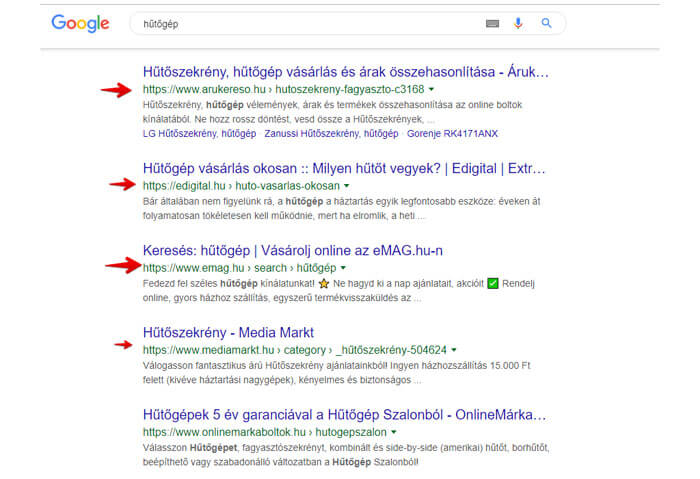
The result is that, excluding the company name, the website ranks 20-100. ranges between places in terms of keyword rankings.
What is the solution?
It is well known that 70% of organic traffic is not made up of "head terms", but long tail terms. These are terms that have low monthly search traffic but also little competition.
These are the keywords that a new, small website should target when starting out.
All this does not mean that there is no possibility of advancement!
But these are the small steps you can take to slowly increase organic traffic, collect positive user signals, and links.
If we already perform well in terms of long tails, we can slowly start creating content for "body terms", i.e. keywords with medium traffic, and here we have a chance to get into the TOP10.
Today, we have a lot of SEO tools at our disposal (e.g.: keywordtool.io in the picture), which can be used to collect long tail terms, either for one keyword at a time, or by collecting competitors' keywords.
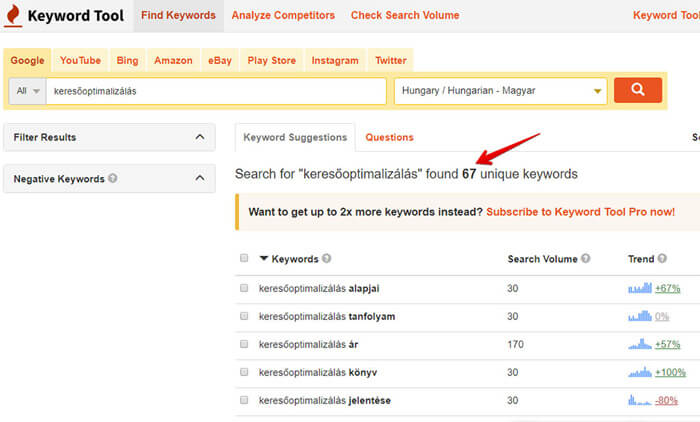
It is worth using these to get a lightning start.
Technical SEO errors
Although the above two areas are the most common and are primarily responsible for the loss of potential organic traffic, there are also typical SEO technical mistakes, although their importance tends to be overestimated by website owners.
Unfortunately, I have very often found that during an SEO Audit of a website, technical errors are the ones that are corrected, but content and keyword targeting errors are not.
What is the reason of this? Usually, a website has/had a developer who can fix technical errors. Moreover, these are typically one-time tasks. In this way, there is a ready-made solution for repairing them, since there is a person who can be entrusted with it and the task/error correction is specific and one-time.
Unfortunately, however, correcting SEO technical errors is a necessary but not sufficient condition for the website's organic traffic to start growing. Without content and keyword targeting, correcting SEO technical errors will not bring an increase in traffic.
But let's see what the most common technical SEO mistakes are!
Duplications
The most common SEO technical error is duplication. Duplication here means that the same content is available on more than one URL.
While Google doesn't penalize duplicate content, according to company spokesperson Gary Illyés, duplication:
“burns crawl budgets and dilutes (ranking) signals”
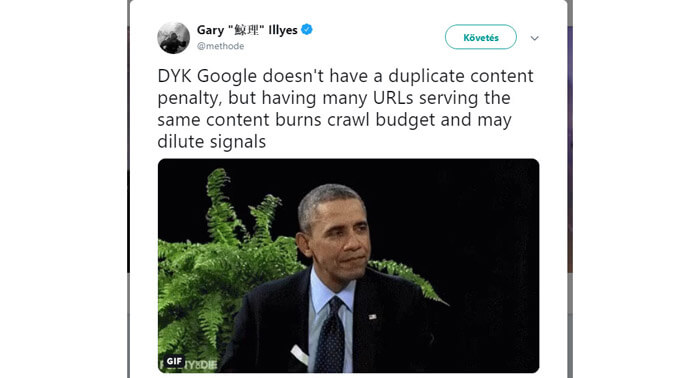
So you definitely have to deal with it.
The most common causes of duplication on the category pages of online stores are new URLs generated by different row arrangement options.
But depending on the content manager, duplicate product pages are not rare either. It is impossible to give concrete examples, since there are as many possible duplication errors as there are websites.
However, it can be said that in 90% of cases parameterized URLs are responsible for duplication, but a typical error is also the duplication of the main page.
De-indexing of low-quality content
This is a bit of a boundary between technical and content SEO, but it is very common for domestic websites. The point is that CMSs often generate low-quality URLs. For Wordpress pages, this is the author or date archives, or tag pages containing 1-2 articles. It is very typical for Wordpress sites that a website has more tag pages than blog posts.
Why is all this important?
Well, as John Mueller, another Google spokesperson, said several times, Google determines the quality of a page based on the content of all indexed URLs. If there are many low-quality URLs, the quality of the website as a whole is also lower in the eyes of Google.
This can be handled with simple canonical and noindex settings. in the case of the same content, canonical settings are the solution, while in the case of low page quality, noindex (or content development) is the solution.
Of course, not only tag pages can be a problem, URLs often appear in Google's index that neither the developer nor the page owner knows about.
That's why it's always worth checking in Search Console how many URLs Google indexes from the website and comparing this with how many pages with unique content we think we have. If the difference is large, it indicates an indexing error.
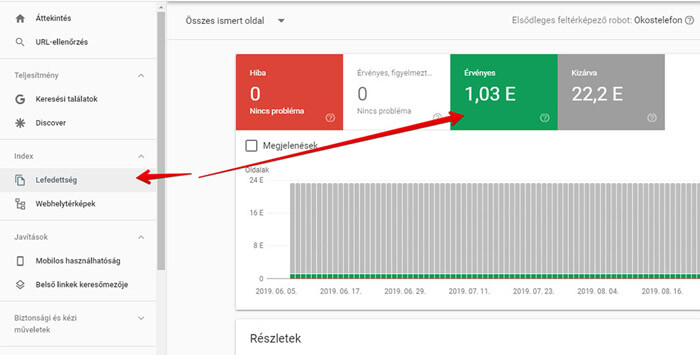
De-indexing of search results
This would also fit into the error circle above, but it is so typical that it is worth mentioning separately. And this is nothing more than the de-indexing of the search pages within the site.
The point here is that with many CMS, if the user starts a search within the page, each search creates a new URL.
And this contributes a lot of very weak pages to all the indexed pages of the website.
Eradicating these is very important, as search pages can really drag down the quality of the site as a whole in the eyes of Google.
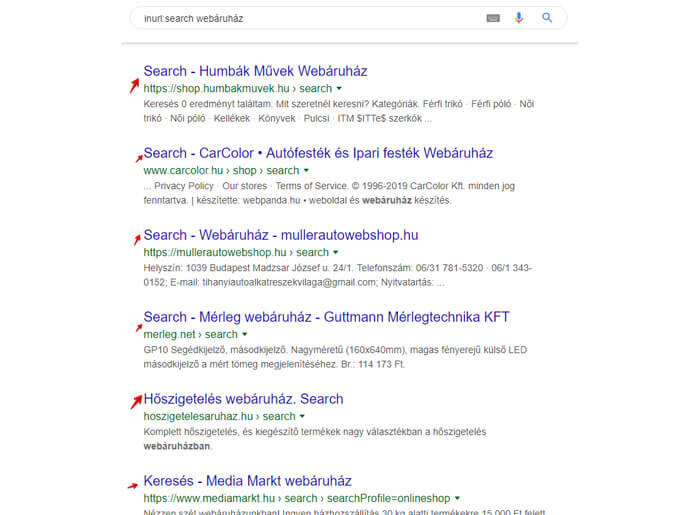
Lack of structured data
It is quite typical that websites do not use even the most obvious structured data. Today, there are many such markings possible, and from an SEO point of view, those that provide a unique appearance on the search results list are of the utmost importance
Especially for webshops, the display of price, stock, or user evaluations as structured data is missing, so they cannot appear in the hit list - ensuring a better click-through rate.
Missing analytical data
Even today, it is very common that when I am asked to do an SEO Audit, the website does not have a Search Console account. However, this is the basis of all SEO analysis, which provides a lot of information. This clearly shows that the owner of the website is completely blind when it comes to search engine optimization.
In terms of Google Analytics, the situation is already better, but here too the error is that GA is not connected to Search Console, Adjusted Bounce Rate is not set correctly, IP addresses are not filtered, and so on.
Redirection errors and omissions
Finally, what can be said to be a typical error is the incorrect handling of those redirects. This error can be particularly serious if the URLs are changed during a design change. If the old URLs do not receive a 301 redirect to the new URL, the effects can be catastrophic, up to 90% of organic traffic can be lost.
But even if there is no design change, it is still very common to use a 302 redirect instead of a 301, or to handle 404 pages inappropriately.
More SEO technical errors
The above can be called the most typical search engine optimization errors, but a lot of less frequent errors could also be mentioned, starting with poor loading speed and even non-mobile-friendly pages.
The SEO Audit is something if…
Finally, as a final word, let me say that an SEO Audit is worth something if what is written in it is implemented.
In most cases, I come across that a 50-page SEO Audit is prepared, which the client orders, and then half a year later I see that no progress has been made in implementing what was described. This is the most typical mistake of all.
In the best case, technical errors are rectified, but sometimes they are only partially rectified.
As a final piece of advice, I recommend that you carry out an SEO Audit when you already know in advance who will be able to carry out what is described in it:
- technical
- content
- and SEO specific
improvement and execution of its tasks. Without this, the SEO audit will just be a waste of money.

